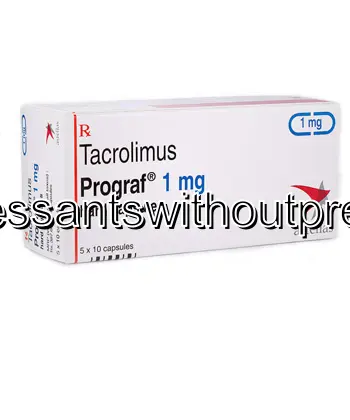| Package | Dosage | Price | Price per Dose | |
|---|---|---|---|---|
| Dosage: 0,5mg | ||||
| 90 pill | 0,5mg | $567.80 | $6.30 | |
| 60 pill | 0,5mg | $403.52 | $6.73 | |
| 30 pill | 0,5mg | $224.88 | $7.50 | |
| 20 pill | 0,5mg | $157.89 | $7.90 | |
| 10 pill | 0,5mg | $84.52 | $8.52 | |
| Dosage: 1mg | ||||
| 90 pill | 1mg | $797.48 | $8.87 | |
| 60 pill | 1mg | $570.99 | $9.52 | |
| 30 pill | 1mg | $336.53 | $11.20 | |
| 20 pill | 1mg | $250.40 | $12.50 | |
| 10 pill | 1mg | $140.34 | $14.10 | |
| Dosage: 5mg | ||||
| 20 pill | 5mg | $760.80 | $38.01 | |
| 10 pill | 5mg | $425.85 | $42.57 | |

Tacrolimus Description
Understanding Tacrolimus: An Overview
Tacrolimus is a powerful immunosuppressive medication primarily used to prevent organ rejection in transplant recipients. Its effectiveness has made it a vital component in transplant medicine, helping to improve the long-term success rates of organs such as the kidney, liver, and heart. Tacrolimus works by inhibiting the activity of T-lymphocytes, which are responsible for mounting an immune response against transplanted tissues. By suppressing this response, the medication minimizes the risk of rejection, allowing the transplanted organ to function properly within the recipient's body.
How Tacrolimus Works
The mechanism of action of tacrolimus involves binding to a specific protein called FKBP-12. This complex then inhibits calcineurin, an enzyme crucial for activating T-cells. Without activation, the immune system's response is dampened, making it less likely to attack the transplanted organ. Tacrolimus is usually administered in oral form, as a capsule or liquid, but can also be given intravenously in certain situations. The medication requires close monitoring of blood levels because of its narrow therapeutic window. Too low a dose may be ineffective, leading to rejection, while too high can cause toxicity and severe side effects.
Potential Benefits of Tacrolimus
Patients prescribed tacrolimus often experience improved transplant outcomes. Compared to earlier immunosuppressants, tacrolimus has been shown to reduce the incidence of organ rejection significantly. Many users report that, when used correctly under medical supervision, tacrolimus effectively maintains the health and function of their transplanted organs. It also allows for a relatively flexible dosing schedule, which can be adjusted based on individual response and blood test results. Overall, it represents a cornerstone medication in modern transplant medicine due to its high efficacy.
Possible Side Effects and Risks
While tacrolimus offers considerable benefits, it can also lead to a variety of side effects. Common issues include tremors, headaches, high blood pressure, and gastrointestinal discomfort. More serious concerns involve kidney damage, which is particularly relevant given its nephrotoxic potential. Additionally, tacrolimus can impair wound healing and increase susceptibility to infections, owing to its immunosuppressive nature. Some users may also experience neurological symptoms such as mood changes or insomnia. Due to these risks, regular blood tests and clinical monitoring are essential during treatment to ensure safe and effective medication levels.
Precautions and Considerations
Before starting tacrolimus, it is important to inform your healthcare provider about any pre-existing health conditions, especially kidney disease, liver issues, or infections. Patients should also disclose all other medications they are taking, as drug interactions can affect tacrolimus levels and increase the risk of adverse effects. Pregnant and breastfeeding women need to discuss potential risks with their doctor, as safety during pregnancy is not fully established. Additionally, lifestyle factors such as avoiding alcohol and certain foods may be recommended to help manage side effects and improve overall treatment success.
Long-term Use and Monitoring
Long-term therapy with tacrolimus requires ongoing medical supervision. Patients need regular blood tests to monitor drug levels, kidney and liver function, and to detect early signs of toxicity. Adherence to prescribed dosages is crucial for maintaining the delicate balance between preventing rejection and minimizing side effects. Adjustments to the dose may be necessary over time, based on the patient’s response and changes in health status. Patients should maintain open communication with their healthcare team to ensure optimal outcomes and to promptly address any emerging concerns.

